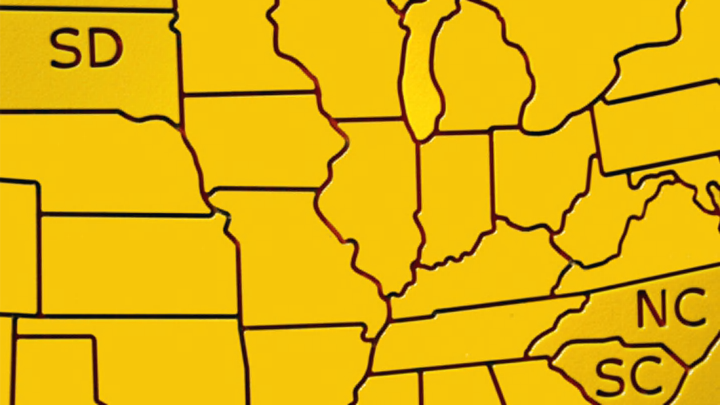It’s possible you’ve heard of North and South Dakota. You may have also heard about North and South Carolina. If so, then you already know that these states are strong, independent honeys makin’ money.
But why did these states divide to become geographic variants of each other? Here are the answers.
North and South Carolina

The foundation and settlement of the Carolinas—originally dubbed the Carolana Colony—was a comedy of errors ... an extremely bloody and diseased comedy of errors.
Early French settlers arrived only to be immediately driven out by Native American tribes. There was open rebellion, corrupt officials, uncontrollable strains of malaria and smallpox, and a dirty lunatic who called himself the pirate Blackbeard (top) prowling up and down the Carolina ports tormenting landlubbers. (His ship, the Queen Anne’s Revenge, was recently discovered off the coast of North Carolina.) When it came to becoming a thriving new colony, Carolana was all thumbs.
In 1629, Sir Robert Heath claimed the Cape Fear territory under King Charles I of England. Heath made no attempts at colonizing the area (because, see above), and following the execution of King Charles I in 1649, Heath fled to France where he died. Heath’s heirs would eventually try to reassert their claim to the territory, but King Charles II ruled the claim invalid and passed the land off to an 8-person club of very rich white men, known as the Lords Proprietors. The Lords—helmed primarily by Lord Shaftesbury and an enigmatic assistant named John Locke—would retain control of the area from 1663 to 1729.
The Lords Club proved to be totally ineffectual. They fought constantly and were unable to make decisions that made sense for the enormous land. The governors they had appointed were nothing but a hilarious laundry list of disasters: "John Jenkins was deposed," "Thomas Miller was overthrown and jailed by ... 'armed rebels'," "Thomas Eastchurch was forbidden to enter the colony," and "Seth Sothel was accused ... of numerous crimes for which he was tried, convicted, and banished." The Proprietors themselves disagreed about everything from the church to dealing with the Tuscarora and Yamasee tribes (all-out war would eventually break out with both tribes).
In 1710, after nearly two years of the Carolina territory living virtually ungoverned, the Proprietors appointed Edward Hyde as the governor of North Carolina, rather than the government of Carolina. In 1729, North and South Carolina were officially recognized as separate royal colonies until the Revolutionary War.
Other than this horror show of a beginning and total inability of its early leaders to agree on anything, there does not seem to be any significant reason for the split.
North and South Dakota

Unless you were a fur trapper or a trapped fur, it was unlikely that you were anywhere near the Dakota territory before the Louisiana Purchase in 1803.
Not until the 1874 discovery of gold in the Black Hills—sacred land to the Sioux—did prospectors really begin settling the area, wherein the word “settling” means "cannibalizing the land and escalating hostilities with the Sioux." (Ironically, Dakota is a Sioux word meaning “friends” or “allies.”) Railroads quickly followed the gold rush; settlers poured into the Dakota prairie and the population surged. Until 1883, the capital of Dakota Territory had been located in southeastern Yankton. Northerners, growing quickly and in need of governance, refused to recognize the remote area as the state capital and declared their own: Bismarck. This caused enough tension to facilitate a split in the land, and rather than pull this car over until you two knock it off, I mean it, Congress indulged the young state and cut a line straight down the 46th parallel.
In 1889, under the Enabling Act, both North and South Dakota were admitted to the union, becoming the 39th and 40th states, respectively. South Dakotans—in addition to creating their own constitution—christened Pierre as their capital, selected for its proximity to the new geographical center of the state. The town of Yankton was unceremoniously dumped. (Rumor has it that if you chant "Yankton" three times while looking in the mirror on Halloween, it will appear extremely rejected and sad.)
Most historians agree that the real reason for Congress’s eagerness to accept the separate Dakotas was a Republican ploy to bolster numbers in Congress. Former Indiana Senator Benjamin Harrison, a Republican (and noted man with a beard), became president in 1889. Congress had been predominantly Democratic until Harrison took office, and the admission of the two Dakotas gifted the House with a Republican majority.
